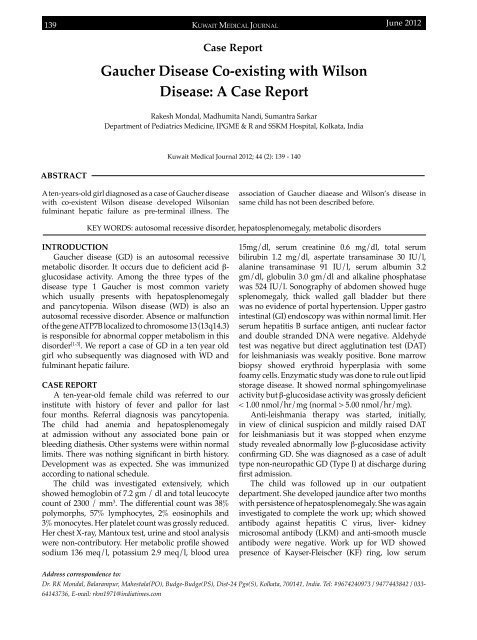Vol 44 # 2 June 2012 - Kma.org.kw
Vol 44 # 2 June 2012 - Kma.org.kw
Vol 44 # 2 June 2012 - Kma.org.kw
You also want an ePaper? Increase the reach of your titles
YUMPU automatically turns print PDFs into web optimized ePapers that Google loves.
139<br />
KUWAIT MEDICAL JOURNAL<br />
<strong>June</strong> <strong>2012</strong><br />
Case Report<br />
Gaucher Disease Co-existing with Wilson<br />
Disease: A Case Report<br />
Rakesh Mondal, Madhumita Nandi, Sumantra Sarkar<br />
Department of Pediatrics Medicine, IPGME & R and SSKM Hospital, Kolkata, India<br />
Kuwait Medical Journal <strong>2012</strong>; <strong>44</strong> (2): 139 - 140<br />
ABSTRACT<br />
A ten-years-old girl diagnosed as a case of Gaucher disease<br />
with co-existent Wilson disease developed Wilsonian<br />
fulminant hepatic failure as pre-terminal illness. The<br />
association of Gaucher diaease and Wilson’s disease in<br />
same child has not been described before.<br />
KEY WORDS: autosomal recessive disorder, hepatosplenomegaly, metabolic disorders<br />
INTRODUCTION<br />
Gaucher disease (GD) is an autosomal recessive<br />
metabolic disorder. It occurs due to deficient acid β-<br />
glucosidase activity. Among the three types of the<br />
disease type 1 Gaucher is most common variety<br />
which usually presents with hepatosplenomegaly<br />
and pancytopenia. Wilson disease (WD) is also an<br />
autosomal recessive disorder. Absence or malfunction<br />
of the gene ATP7B localized to chromosome 13 (13q14.3)<br />
is responsible for abnormal copper metabolism in this<br />
disorder [1-3] . We report a case of GD in a ten year old<br />
girl who subsequently was diagnosed with WD and<br />
fulminant hepatic failure.<br />
CASE REPORT<br />
A ten-year-old female child was referred to our<br />
institute with history of fever and pallor for last<br />
four months. Referral diagnosis was pancytopenia.<br />
The child had anemia and hepatosplenomegaly<br />
at admission without any associated bone pain or<br />
bleeding diathesis. Other systems were within normal<br />
limits. There was nothing significant in birth history.<br />
Development was as expected. She was immunized<br />
according to national schedule.<br />
The child was investigated extensively, which<br />
showed hemoglobin of 7.2 gm / dl and total leucocyte<br />
count of 2300 / mm 3 . The differential count was 38%<br />
polymorphs, 57% lymphocytes, 2% eosinophils and<br />
3% monocytes. Her platelet count was grossly reduced.<br />
Her chest X-ray, Mantoux test, urine and stool analysis<br />
were non-contributory. Her metabolic profile showed<br />
sodium 136 meq/l, potassium 2.9 meq/l, blood urea<br />
15mg/dl, serum creatinine 0.6 mg/dl, total serum<br />
bilirubin 1.2 mg/dl, aspertate transaminase 30 IU/l,<br />
alanine transaminase 91 IU/l, serum albumin 3.2<br />
gm/dl, globulin 3.0 gm/dl and alkaline phosphatase<br />
was 524 IU/l. Sonography of abdomen showed huge<br />
splenomegaly, thick walled gall bladder but there<br />
was no evidence of portal hypertension. Upper gastro<br />
intestinal (GI) endoscopy was within normal limit. Her<br />
serum hepatitis B surface antigen, anti nuclear factor<br />
and double stranded DNA were negative. Aldehyde<br />
test was negative but direct agglutination test (DAT)<br />
for leishmaniasis was weakly positive. Bone marrow<br />
biopsy showed erythroid hyperplasia with some<br />
foamy cells. Enzymatic study was done to rule out lipid<br />
storage disease. It showed normal sphingomyelinase<br />
activity but β-glucosidase activity was grossly deficient<br />
< 1.00 nmol/hr/mg (normal > 5.00 nmol/hr/mg).<br />
Anti-leishmania therapy was started, initially,<br />
in view of clinical suspicion and mildly raised DAT<br />
for leishmaniasis but it was stopped when enzyme<br />
study revealed abnormally low β-glucosidase activity<br />
confirming GD. She was diagnosed as a case of adult<br />
type non-neuropathic GD (Type I) at discharge during<br />
first admission.<br />
The child was followed up in our outpatient<br />
department. She developed jaundice after two months<br />
with persistence of hepatosplenomegaly. She was again<br />
investigated to complete the work up; which showed<br />
antibody against hepatitis C virus, liver- kidney<br />
microsomal antibody (LKM) and anti-smooth muscle<br />
antibody were negative. Work up for WD showed<br />
presence of Kayser-Fleischer (KF) ring, low serum<br />
Address correspondence to:<br />
Dr. RK Mondal, Balarampur, Mahestala(PO), Budge-Budge(PS), Dist-24 Pgs(S), Kolkata, 700141, India. Tel: #9674240973 / 9477<strong>44</strong>3842 / 033-<br />
64143736, E-mail: rkm1971@indiatimes.com
















